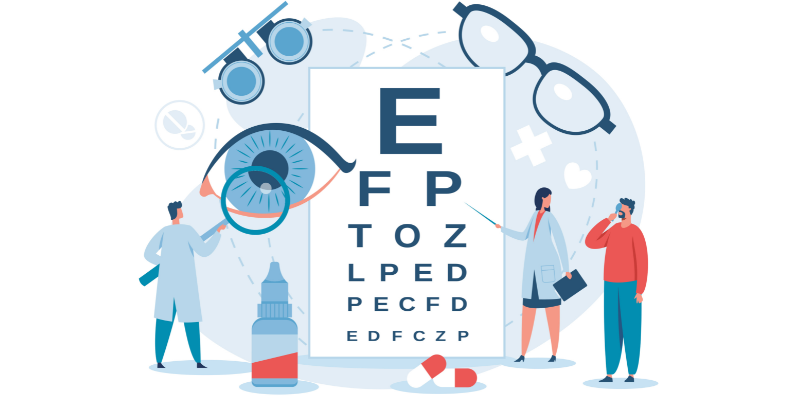By Sue Sveum
Annual physical? Check. Twice-a-year dental exam? Check. Annual eye exam? What? That’s pretty much the response to a 2020 American Optometric Association (AOA) survey showing that as many as one-third of respondents weren’t taking the necessary steps to care for their eyes — and just 54% of respondents had gotten a yearly eye exam.
Four SSM eye health providers give us the rundown on everything from cataracts and LASIK surgery, to the importance of having regular eye exams — and even choosing the right sunglasses. Take a look.
Take Care of Your Eye Health
Just like seeing your primary care provider for a yearly physical, it’s important to have regular eye exams. Unfortunately, many people without obvious vision problems may think it’s not important — much less a priority. But according to optometrist Dr. Nicole Zindl of SSM Health, it should be.
“During a comprehensive eye exam, eye care providers look at much more than just how many letters you can read on a chart — we assess how the eyes work together, how they focus, your peripheral (side) vision, your eye pressures and overall eye health,” explains Zindl. “Your eye health can also provide insight into the health of the rest of your body.”
Wondering how often you should go? Here’s a general adult guideline.
- 18 to 39 – every 5-10 years
- 40 to 54 – every 2-4 years
- 55 to 64 years – every 1-3 years
- 65 years or older – every 1-2 years
“These frequencies may differ for those with glasses or contacts, a family history of eye disease, systemic health issues, or new or worsening eye symptoms,” explains Zindl, “as well as anyone with diabetes, high blood pressure, high cholesterol, autoimmune disease or cancer.”
It’s also important to see your provider if you have a family history of the following conditions, which can be detected with a comprehensive eye exam — often long before patients notice any warning signs.
- glaucoma
- macular degeneration
- strabismus (eye turn)
- retinal detachment
- early cataracts
And see your eye care provider if you notice any of these symptoms.
- changes to quality of vision
- sudden increase in floaters
- flashes of light or a dark curtain in your vision blacking out of vision in one or both eyes
- newly-noted double vision
There are also a couple of irritating but easily- corrected eye conditions.
“Most people start to notice some level of blurriness with “near” vision in their 40s — typically corrected with reading glasses or bifocal lenses,” says Zindl. And the other common complaint? Dry eye or itchy watery eyes from allergies. Your provider can help you manage these symptoms.
“And surprisingly, many general health conditions can first be detected in the eye — before they’re even diagnosed,” says Zindl. That’s why it’s so important to have exams as recommended.
Consider your optometrist a “primary care provider” for your eyes. They’ll help you maintain and protect your best vision, and can manage most eye conditions up to the point of surgical intervention — determining if and when a referral to a specialist is required.
“Preserving existing vision,” stresses Zindl, “is much easier and effective than trying to recover vision that’s been lost.”
What is Cataract Surgery?
The words “I can see clearly now” are more than just song lyrics to anyone who’s undergone cataract surgery — they’re an anthem of awe for clear vision. But is it right for you? Michael Yablick, MD, comprehensive ophthalmologist at SSM Health, shares all you need to know about cataracts.
So, who gets cataracts? “Nearly everyone!” says Yablick. “Cataracts come with age, so most everyone will develop cataracts at some point if they live long enough.” You may notice early signs of cataracts around the age of 50 or so, but most people seek surgery between their 60s and 80s.
Common signs of cataracts are:
- hazy or filmy vision
- increased starbursts
- halos around lights
- need for more reading light
- duller-appearing colors
- frequent changes in your glasses prescription
When symptoms affect daily activities — and glasses or contacts don’t help — it’s time to think about cataract surgery, according to Yablick. With that decision made, what should you expect?
- Cataract surgery is an outpatient procedure, taking about 15 minutes.
- General anesthesia isn’t required.
- There’s typically little or no pain during or after surgery.
- A specialized ultrasonic machine breaks up the cloudy lens and removes it from the eye, and an artificial lens is inserted to help correct vision.
- Improvement in brightness, color and clarity may be noticeable the day after surgery, but the full benefit often takes days or weeks.
You may know former glasses-wearers who’ve ditched their specs after cataract surgery — but that’s not always the case.
“Patients most likely to need glasses post-surgery may have very large or very small eyes, greater astigmatism or have had previous refractive surgery (like LASIK),” explains Yablick. “Many people will still require reading glasses.”
Since cataracts typically develop over many years, patients may not realize how bad their vision has become. Surgery can bring back the ability to drive or read.
“The large vision change in such a short time is one of the most satisfying things about cataract surgery,” says Yablick. “I hear all the time that patients wish they’d had surgery sooner.”
See the World Clearly with Laser Eye Surgery
If you grew up wearing glasses, you’ve probably heard of LASIK surgery. But is it right for you? Dr. Stephen Boorstein, ophthalmologist and corneal refractive surgeon, with SSM Health Davis Duehr Dean Eye Care, describes how laser vision correction, or corneal refractive surgery, corrects common vision conditions — like nearsightedness, farsightedness and astigmatism.
“With LASIK, a specialized laser is used to perform a treatment that is customized to each patient. The laser reshapes the cornea and changes the overall power of the eye, allowing you to become less dependent on glasses and contacts,” says Boorstein.
Boorstein says every patient undergoes a meticulous screening process before qualifying for the surgery to assess various factors, including the shape of your eyes, your current glasses and contact lens prescription — and other factors such as personality, profession and vision goals.
“We then examine your eyes extensively,” he adds, “and recommend whether LASIK is safe and beneficial for you.”
In general, good candidates:
- are between 21 and 60
- aren’t pregnant or currently breastfeeding
- are in good health, with no eye conditions such as cataracts, glaucoma or dry eye disease
- don’t have corneas that are irregular, scarred or too thin for treatment
- don’t have uncontrolled diabetes
- don’t have severe autoimmune disease
LASIK surgery typically takes about 10 minutes per eye and isn’t painful — although you may feel eye irritation for a few hours. Most patients can return to work the next day. And best of all? Post-surgery recovery and vision improvement is quick; most can see better within seconds after the procedure, have good vision in a day or two, and reach their best vision within just a few weeks of surgery.
Although LASIK provides long-term improvements in your vision, the benefits can decrease over time. A yearly eye exam is important to ensure the continued health of your eyes. “As your eyes change throughout your life, your vision and prescription will change too,” says Boorstein. “At some point, particularly in your 60s and above, you may require corrective lenses for the best vision.”
And between ages 40 and 50? You’re likely to need reading glasses, whether you’ve had LASIK or not.
Sunglasses: Wearable Sunscreen for Your Eyes
Sunglasses may be a fashionable way to see better on sunny days — but be sure that yours protects your eyes from harmful ultraviolet (UV) rays. Here are some tips.
- Not all sunglasses have UV protection.
UV protection is what shields your eyes. When shopping for sunglasses, look for a sticker or tag denoting UV protection. - Lens color and darkness are not related to ultraviolet protection.
No matter the tint, always be sure to have good UV protection. - Choose polarized lenses.
A special filter helps block glare, making driving or being outside easier on the eyes. - Kids need sunglasses too.
Children typically get more sun exposure than adults — so check their sunglasses for UV protection. - Sunglasses are cool on cloudy days.
UV rays penetrate clouds even when it’s overcast — so wear your shades regardless of weather.




